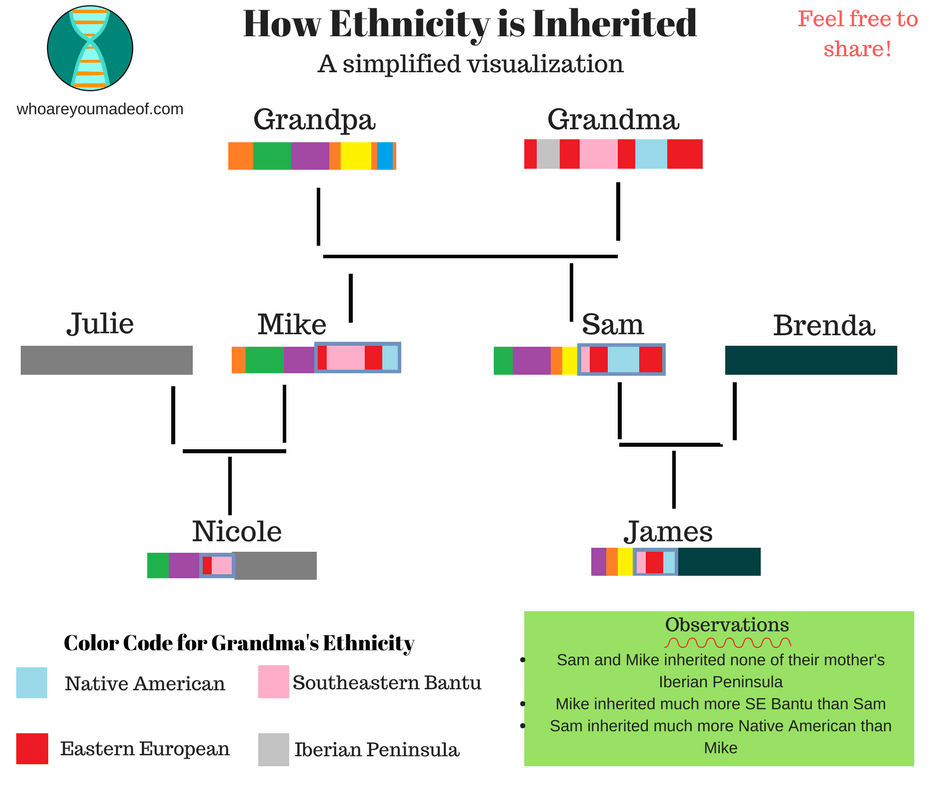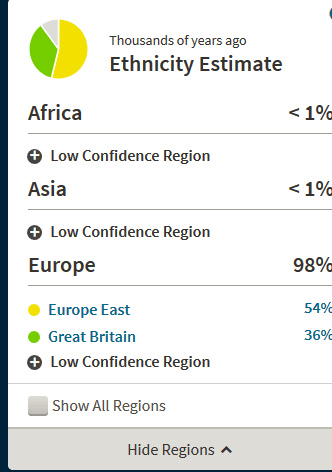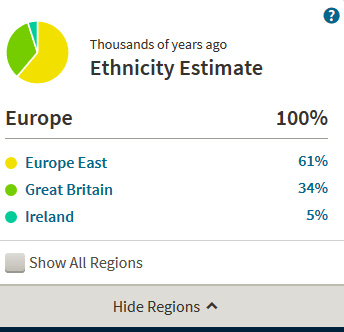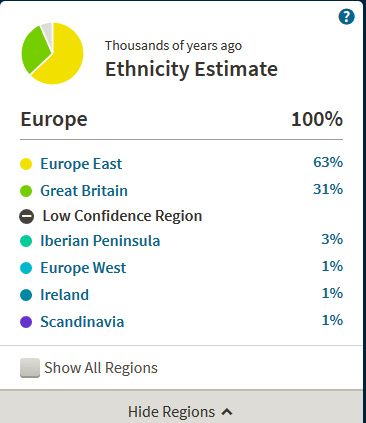One of the most popular reasons for doing a DNA test is to determine ethnicity. Many people start out on their DNA journey trying to learn about their ethnicity and end up discovering new family members, or learning something really cool about their family history. Is there such a thing as a DNA test for ethnicity, and if so, which one is the best?
The simple answer is that yes, you can use a genealogy DNA test to find your ethnicity, generally speaking.
My favorite DNA test for finding ethnicity is Ancestry DNA. My second favorite is 23 and Me. The way Ancestry presents their DNA results is easy to understand, and their test is general less expensive than 23 and Me. I have also found Ancestry DNA's ethnicity estimates very closely represent what I have been able to research the old-fashioned way, both in my family and that of my husband and other family members.
How Does a DNA Test for Ethnicity Work?
In order to truly understand what a DNA estimate is, we have to get a little bit scientific. The DNA testing companies use something called "sample populations" in order to give you your ethnicity estimate. Their laboratories compare your DNA with that of thousands of people from all over the world. In order to become a part of the same population, the participants would have needed to prove that they and their ancestors have lived in the same geographic area for several generations. Their DNA is then grouped by geographic area.
This means that your DNA will be compared to the people who currently live in those geographic areas, and whose families have been there for hopefully a few hundred years - if not longer.
Is this a perfect method? No, but it's a good way to get a general idea about where your ancestors were from. Genealogical DNA tests can tell you a lot about your ancestry going back 300-500 years in time, for the most part. They can also tell you a little bit about your ancestry going even further back. This is why comparing your DNA to those whose families have stayed in a particular area for a long time is a fairly accurate way to perform the estimate.
There is one really, really important thing to know about this estimate, however. Each child inherits 50% of their DNA from each parent. That means that 50% of their parents' DNA does NOT get passed down to the child. This can mean that a child of a 100% Eastern European person will only show 50% Eastern European DNA, and their grandchild will only show 25%, and their great-grandchild 12.5% - in a perfect scenario.
A Test for Ethnicity - How is Ethnicity Inherited?
In the case of a great-grandchild, or a great-great-grandchild, something even stranger can happen. Remember that a child will get half of their mother's DNA, but there is never ever guarantee which 50%. The way it is chosen is fairly random, as far as scientists know. Take the example of the 100% Eastern European person. Their great-grandchild will inherit 50% of their DNA from their part-Eastern European parent, but there is a good chance that they won't inherit all of the Eastern European DNA that they could potentially inherit. It's possible for a person to share NO DNA with a great-great grandparent, even though there is a verified genealogical relationship.
So when people ask if DNA ethnicity tests are accurate, this is why I say "generally" accurate. They are very accurate for a few generations back, but it's basically the luck of the draw if you are trying to find an ethnicity from a long time ago.

So How do I Research Trace Ethnicity?
The best way to find the ethnicities that have been lost, or washed out, as some people say, is to have multiple family members do a DNA test. If you have siblings, aunts, uncles, grandparents, etc, who are willing to test along with you, then you will learn much more about the historical ethnicities of your family.
For example, my mother and two of her full siblings have done a DNA test. Their grandparents were from the Germany, Poland, Slovakia, and Ireland/England, based on genealogy records. Below, I will show you how different their results are, and why it is so beneficial to have more than one sibling (or even better, a parent!) do the DNA test.
Sibling 1

Sibling 2

Sibling 3

Wow! The amount of Eastern European varies from 54% to 63%. These are verified full siblings - meaning that they had the same parents. What has obviously happened is that each sibling inherited different DNA from each parent, which is what always happens. Some DNA is always lost from each parent, no matter how many children that they have. If you are interested in doing a DNA test for ethnicity purposes, it is really helpful to have your siblings or parents do the test, as well.
How Can You Can Find Your DNA Ethnicity?
Yes, you can use Ancestry DNA to find your ethnicity, and it is pretty accurate. It's also a lot of fun!
If you want more accuracy, or you are looking for those trace ethnicities that might have been lost through the generations, order more than one kit to test as many people as you can in your family to see what you can find.
Thank you so much for stopping by! And of course, if you have any questions or anything to add, I would love to hear from you in the comments,


John Torma
Saturday 6th of January 2018
I understand that one inherits 50% of a mix of each parents DNA from each parent. I am over 60 years old, so my parents and grandparents are dead, but I knew them and we discussed where we came from with all, a lot. All grandparents were immigrants or children of the immigrant family. We have traveled back to where we have come from and met cousins that still live there. I understand that any family can have secrets. But I don’t understand how I inherited 59% of my DNA from my mother who is 100% Eastern European? How could I have inherited that 9% more from her? As for my father, whose mother is 100% Norwegian and father 100% Swiss, my DNA is 28% Scandinavian, but 10% Iberian Peninsula, and only 2% Western Europe with less than 1% Ireland/Scotland/Wales? I met my family still in Switzerland, several times. I look more like them than I do any of my moms family, that’s for sure; like I look strikingly like my great aunt, my grandfathers sister. I am even aging like her. But I only inherited 2% of that side of the families DNA? And I guess I don’t understand how 28% Scandinavian, and let’s say that the 10% Iberian 2% Western European and <1% Ireland/Scotland/Wales is all from my father, that does not add up to 50% from my father? Very confused, Jane
nomakelidat
Sunday 3rd of September 2017
As far as I know this test won't tell me if i have portuguese or not. It will tell me if i"m from iberian peninsula that's all. Am i correct?
Mercedes
Thursday 14th of September 2017
Hi, yes, you are correct. This test will not be able to specifically tell you if you have Portuguese ancestry. It should show up as Iberian, primarily, though people from Portugal can often show DNA from other regions, too. Sorry for the late response, I was traveling for a few days :). Thank you so much for your comment!